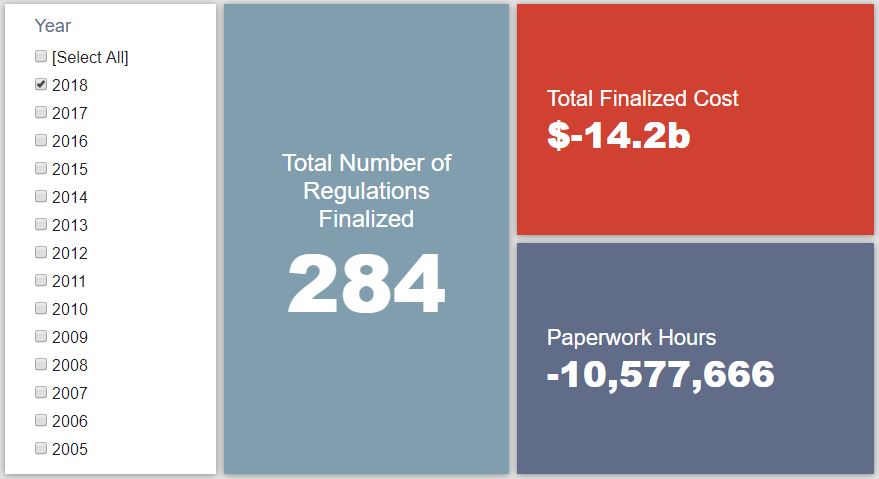Week in Regulation
November 26, 2018
Pipes, Trains, & Medicare Payments
While many Americans were busy traveling home for the Thanksgiving holiday, the pages of the Federal Register were stuffed to the brim with deregulatory measures. Fittingly, the Department of Transportation (DOT) was among the most active on this front. The Centers for Medicare and Medicaid Services (CMS), however, saw the largest cost reductions. Between both proposed and final rules last week, agencies published roughly $3.8 billion in net cost savings, and reduced paperwork by 1.9 million hours. The per capita regulatory burden for 2018 is negative $43.34.
REGULATORY TOPLINES
- New Proposed Rules: 23
- New Final Rules: 50
- 2018 Total Pages of Regulation: 60,045
- 2018 Final Rules: -$14.2 Billion
- 2018 Proposed Rules: -$545 Billion
TRACKING REGULATORY MODERNIZATION
CMS published two rules that – over the course of 830 pages – make a plethora of changes to different parts of the Medicare system. As in past instances, while these rules are generally devoted to adjusting the level of transfer payments to various providers, CMS has been able to include administrative efficiency reforms in order to cut the costs that affected entities face. Across these two rules combined, CMS reduced annual paperwork burdens by more than 1.7 million hours and annual costs by $212.5 million (which equates to roughly $3 billion in terms of “present value” savings). Such savings put the Department of Health & Human Services as a whole a mere $6 billion away from its ambitious fiscal year (FY) 2019 savings goal under Executive Order (EO) 13,771 of nearly $9 billion.
DOT was also rather busy on the deregulatory front. In its most notable action, the department finalized a rule proposed in 2016 regarding “Standards for Alternative Compliance and High-Speed Trainsets.” The rule creates greater flexibility in how certain “tiers” of trainsets can operate. DOT estimates that this could produced up to $837 million in total cost savings. The other DOT rule updates relevant regulatory code to allow for wider usage of plastic piping in gas pipelines, saving approximately $32 million annually.
So far in FY 2019, there have been 13 deregulatory actions against two regulatory actions (per the rubric created by EO 13,771 and the administration’s subsequent guidance document) with quantified net savings of roughly $5 billion. The administration’s cumulative savings goal for FY 2019 is approximately $18 billion.
STATE OF MAJOR OBAMA-ERA INITIATIVES
Based on total lifetime costs of the regulations, the Affordable Care Act has imposed costs of $52.9 billion in final state and private-sector burdens and 176.9 million annual paperwork hours.
Since passage, the Dodd-Frank financial reform legislation has produced more than 82.9 million final paperwork burden hours and imposed $38.9 billion in direct compliance costs.
TOTAL BURDENS
Since January 1, the federal government has published $559.2 billion in net cost savings (with $14.2 billion in net savings from final rules) and paperwork burdens amounting to roughly 4.5 million hours (including 10.6 million hours of paperwork reduced under final rules). Click here for the latest Reg Rodeo findings.











